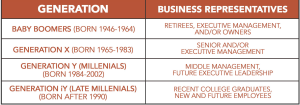They’re different and that’s OK!
 July 28, 2015
July 28, 2015
 No Comments
No Comments
This morning, I had the pleasure to once again hear Dr. Tim Elmore speak on leading Millennials. Today’s focus was specifically about leading, given a generational gap in the workplace. The context of what Dr. Elmore presents applies to relationships period to include the family dynamic.
For those who don’t understand the terminology, I’ve included a summary of the generational terminology taken from Dr. Elmore’s e-book, Managing the Toughest Generation. The majority of today’s content can be found in this e-book; so, I recommend clicking here to obtain a complementary copy.
As can be scene by the chart, Dr. Elmore breaks the Millennials down even further into Gen Y and iY where iY represents those people born after 1990 which represents most employees entering the workforce today. As you might suspect, this generation has been dubbed iY as they represent a generation which has grown up online with iPhones, iPads, iChat, iMovie, iTunes, or the likes.
Whether it be your own children or employees, if you’re a Boomer or Gen X, you likely don’t have to think long to totally relate to challenges in the generational gap between iYs and yourself. Dr. Elmore uses the acronym SCENE to characterize how iYs have grown up.
S – Speed. (Slow is bad)
C – Convenience. (Hard is bad)
E – Entertainment. (Boring is bad)
N – Nurture. (Risk is bad)
E – Entitlement. (Labor is bad)
As a Boomer or Gen X, you can likely related to the value of words like “slow, hard, boring, risk, and labor” versus Gen iY see these as a total waste. In this digital age which keeps getting faster and faster, they’ve grown accustom to things like “speed, convenience, entertainment, nurture, and entitlement”.
Something Dr. Elmore mentioned in the very first session I attended and has always stuck with me is how Gen iYs obtain information and the elder generation’s role. Using the example of children and my paraphrasing, Dr. Elmore says:
It use to be that children came to their parents for information. As such, children tended to form their beliefs and interpret information based off their parent’s teachings. The parents role was to provide this teaching/information. Now with the digital age, kids are bombarded with information from everywhere. With one quick search on Google, they have a vast amount of information right at their finger tips. So, the role of the parent (or elder generation) has now become one of interpretation.
Yes, while presented in the context of a parent/child relationship, the same holds true within your business. Gen iYs aren’t looking to be told how to do things, they want to experience things with your aiding in their interpretation. They must be provided an environment with much more freedom and flexibility to exercise creativity and experimentation.
Dr. Elmore summarized the 3 Greatest Needs of iYs as follows:
1) Emotional Intelligence— Self-awareness, self-management, social-awareness, and relationship management
2) Character Development—Self-discipline, personal values, emotional security, and personal identity
3) Leadership perspective—Possessing vision, problem solving skills, priority setting skills, and execution skills
If you have iYs you’re working, you’d be wise to spend considerable time enrolling them in discussions on how best to meet these 3 Greatest Needs.
I’m confident that today’s post leaves many more questions than answers on how to deal with the generational gap in your business, family, sports team, etc. The main things I’d like to convey is “they’re different and that’s Ok!” This is the emerging generation and we better start learning how to best relate and lead them or we’re going to be left behind.
 Blog Home
Blog Home
Popular Posts
- What should I “Start, Stop, Continue” doing? 19 views
- Waste Not, Profit More: Strategies for Cost Optimization 11 views
- Recap: 12 Key Strategies for Business Growth 9 views
- Beyond Fear: Embracing Price Increases for Business Growth 9 views
- Strategic Internet Marketing: Navigating the Six Essential Avenues 6 views
- Is Lencioni’s The Five Dysfunctions of a Team outdated? 5 views
- If at first you don’t succeed, you’re in good company. 5 views
- Are you embellishing or manipulating to get the sale! 5 views
- Unlocking Revenue Streams: The Power of Joint Venture Partnerships 5 views
- 80% of Sales Happen Here: Decoding the 5th to 12th Touch Points 4 views
Categories
- 5 Part Profit Framework (14)
- Books (31)
- Business (183)
- Case Studies (4)
- Faith (132)
- Family (83)
- Farm 360 (5)
- Finances (19)
- Fitness (6)
- Freedom (21)
- Friends (25)
- Fun (5)
- Hearing God's Voice (58)
- Leadership (94)
- Leadership Development (67)
- Marketplace Ministry (29)
- Mentor (37)
- Personal (185)
- Speaking (7)
- Strategic Planning (57)
- Team Alignment (57)
- Teambuilding (57)
- Teens (24)
- Testimonials (10)
- TPCC (32)
- TruthAtWork (57)
- What Matters (4)


Leave a Reply